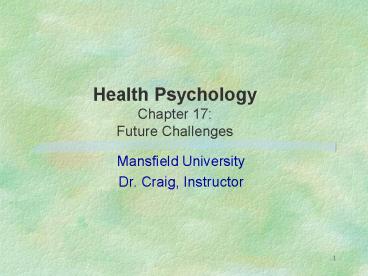Health Psychology Chapter 17: Future Challenges - PowerPoint PPT Presentation
1 / 15
Title:
Health Psychology Chapter 17: Future Challenges
Description:
Health Psychology Chapter 17: Future Challenges Mansfield University Dr. Craig, Instructor – PowerPoint PPT presentation
Number of Views:409
Avg rating:3.0/5.0
Title: Health Psychology Chapter 17: Future Challenges
1
Health PsychologyChapter 17Future Challenges
- Mansfield University
- Dr. Craig, Instructor
2
Where do we go from here?
- Helpful to look at changes in recent past to
point us to the future - well-being - a personal responsibility, medical
professionals just one piece of the health puzzle - declining mortality for Heart Disease Cancer
- increasing amounts of unhealthy behaviors in
places - physical activity, diet, smoking, STDs etc.
- Goal Setting for future Health
- Healthy People 2000 2010
- 3 Major Goals, 22 priority Areas, 300 objectives
within priority areas.
3
Healthy People- Goal 1
- Goal 1 INCREASE HEALTHY LIFE SPAN
- We know people on average are living a bit longer
- but are they living better.
- Dead or Alive-- too simplistic
- Well-year - one year of completely well life,
free of dysfunction, symptoms or health related
problems - Health Expectancy- time a person is free from
disability
4
Longevity, Health and Wellness
- Concepts like WY and HE refocus effort toward
building quality of life, not necessarily
longevity. - Therefore reallocation of attention to issues
that may not threaten life but impact quality of
life - e.g., movement disorders, chronic pain,
respiratory disorder vs. cancer, HD, accidents,
suicide etc. - May be cost-effective for elderly
- WY and HE refocuses attention on prevention and
building health into old age - fewer doctors visits, medications, emergency room
trips - Old need not be synonymous with frail/sick
5
Healthy People Goal 2
- Goal 2 REDUCE HEALTH DISPARITIES
- focus on meeting general standards for all,
instead of targeting groups - Social Economic Factors underlie much of group
differences - education, income, occupational status, ethnic
background - African Americans
- life expectancy, infant mortality, homicides, CVD
deaths, cancer, TB diabetes all much worse than
any other ethnic group.
6
Health Disparities.. cont
- African Americans
- poorer medical treatment, less health education,
discriminatory provision of health care (e.g.) - even poor whites fare better..
- Less likely to live in poverty areas with the
deficiencies that that entails (medical
assessability, good grocery markets, safety
issues etc.) - Native Americans
- all-cause mortality, infectious disease, infant
mortality than groups (other than
African-Americans) - lack of access to medical care
- higher health risk taking behaviors
- SES explains part, but not all of the equation
7
Disparities cont.
- Issues for Hispanic Americans (non-Cuban)
- lower insurance coverage rates
- poorer accessibility to physicians
- greater smoking, hypertension obesity
- Still fare BETTER than Eur-Amer IN ALL-CAUSE
MORTALITY - why? Immigrants not fully adopt all the
unhealthy behaviors available to them in the US - Education
- less than 12 years all kinds of problematic
behavior
8
Goal3 Increasing Access to Preventative Svcs
- Primary Prevention Services
- encourage life style changes
- frequently targets those at risk
- low cost (relative to disease treatment)
- smoking cessation, stress management, physical
activity groups - immunization
- Secondary Prevention
- public screening for disease prior to development
- more costly
- may (like prim. Prevent) add well-years as well
as reduce future disease.--- therefore
cost-benefit ratio improved - radon/lead testing genetic screening
hypertension, cholesterol screening, mammography
HIV screening
9
The Work of Health Psychologists
- Many directions between and within disease
conditions and health behaviors - 1. Gathering data on behavior/lifestyle how
they relate to health (up down) - tradition scientific inquiry, frequently basic
science - 2. Promotion Maintenance of health (down)
- program engendering health, stoking importance of
lifestyle changes - 3. Prevention (up) Treatment(down) of disease
- programs designed to eliminate/reduce specific
disease - 4. Formulate/Shape policy in health/health care
(up) - political business sector effects that change
10
Training in Health Psychology
- 1. Biological bases of behavior/health
- 2. Cognitive-Affective affector of health
- (emotion, attitudes,)
- 3. Social basis for disease/poor health
- Individual Differences health
- personality, sex
- 4. Advanced Research Methods Statistical
Analysis - 5. Measurement of health psychology
- 6. Interdisciplinary Collaboration
- 7. Ethical Professional Issues
- Also, specialization imp. often in form of
Post-Doc
11
Health Psychology A Collaborative Profession
- Health Psychologist- works in variety of work
settings often as part of a team - universities
- teaching research often involves other health
professionals - HMOs/ hospitals
- testing, research, rehab, treatment, policy
- prevention work for HMOs
- Federal Government CDC, NIH
- research treatment)
- Note that all of except perhaps teaching at
universities, the HP is working in an area that
has been historically someone elses turf.
12
Future Challenges Changing Profile of Illness
etc
- Heart Disease vs. Cancer
- both declining in 90s, but HD more rapidly
- figure 17.1 17.2- if trend continues greater
emphasis on psychology of cancer will emerge - Cancer leading cause of prematurely death (40-
65) - 37 of deaths in women compared to 22 for CVD
- men also
- Reduction of Unintentional Injuries-
- car accidents, seatbelt use domestic injury,
computer injury etc. - Aging
- new issues emerge as population ages
- cost-benefit of treatment
13
Future Challenges Aging etc.
- Aging (continued)
- new emphasis on well-year approach, and
maintaining health - health care policy shifts toward prevention?
- Infectious Illness
- Tuberculosis treatment resistant strains
- Medication Communication- getting people to
take all medicines properly---gt tough to do
sometimes - Iatrogenic Infection
- Controlling justifying costs of a health
psychologist - US spending more than anywhere else in the world
and is not in the top 10 for lowest
mortality/disease rates - downstream upstream programs that save
14
(No Transcript)
15
(No Transcript)































